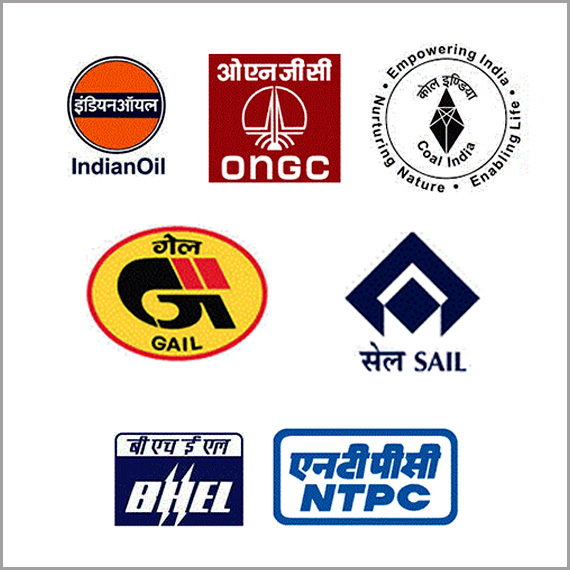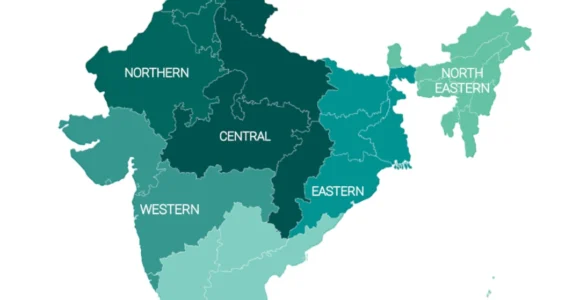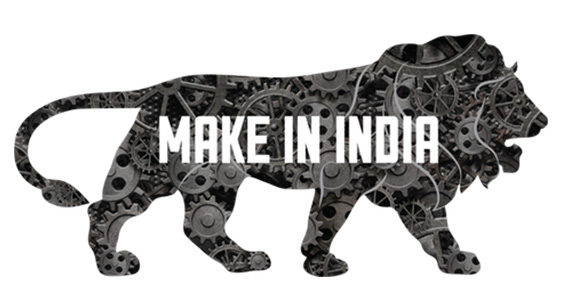
Maharatna, Navratna, Miniratna Companies
State government-owned corporation which are not privatized.
A state-owned enterprise in India is called a public sector undertaking (PSU) or a public sector enterprise. These companies are owned by the union government of India, or one of the many state or territorial governments, or both. The company stock needs to be majority-owned by the government to be a PSU. PSUs may be classified as Central Public Sector Enterprises (CPSEs), public sector banks (PSBs) or State Level Public Enterprises (SLPEs). CPSEs are administered by the Ministry of Heavy Industries and Public Enterprises.
When India achieved independence in 1947, India was primarily an agricultural country with a weak industrial base. The national consensus was in favour of rapid industrialisation of the economy which was seen as the key to economic development, improving living standards and economic sovereignty. Building upon the Bombay Plan, which noted the requirement of government intervention and regulation, the first Industrial Policy Resolution announced in 1948 laid down broad contours of the strategy of industrial development. Subsequently, the Planning Commission was constituted in March 1950 and the Industrial (Development and Regulation) Act was enacted in 1951 with the objective of empowering the government to take necessary steps to regulate industrial development. Prime Minister Jawaharlal Nehru promoted an economic policy based on import substitution industrialisation and advocated a mixed economy. He believed that the establishment of basic and heavy industry was fundamental to the development and modernisation of the Indian economy. India’s second five year plan (1956–60) and the Industrial Policy Resolution of 1956 emphasised the development of public sector enterprises to meet Nehru’s national industrialisation policy. Indian statistician Prasanta Chandra Mahalanobis was instrumental to its formulation, which was subsequntly termed the Feldman–Mahalanobis model.
The major consideration for the setting up of PSUs was to accelerate the growth of core sectors of the economy; to serve the equipment needs of strategically important sectors, and to generate employment and income. A large number of “sick units” were taken over from the private sector. Additionally, Indira Gandhi’s government nationalised fourteen of India’s largest private banks in 1969, and an additional six in 1980. This government-led industrial policy, with corresponding restrictions on private enterprise, was the dominant pattern of Indian economic development until the 1991 Indian economic crisis. After the crisis, the government began divesting its ownership of several PSUs to raise capital and privatise companies facing poor financial performance and low efficiency.
Various PSUs have been awarded additional financial autonomy. These companies are “public sector companies that have comparative advantages”, giving them greater autonomy to compete in the global market so as to “support [them] in their drive to become global giants”. Financial autonomy was initially awarded to nine PSUs as Navratna status in 1997. Originally, the term Navaratna meant a talisman composed of nine precious gems. Later, this term was adopted in the courts of Gupta emperor Vikramaditya and Mughal emperor Akbar, as the collective name for nine extraordinary courtiers at their respective courts.
In 2010, the government established the higher Maharatna category, which raises a company’s investment ceiling from Rs. 1,000 crore to Rs. 5,000 crore. The Maharatna firms can now decide on investments of up to 15 per cent of their net worth in a project while the Navaratna companies could invest up to Rs 1,000 crore without explicit government approval. Two categories of “Miniratnas” afford less extensive financial autonomy.
Guidelines for awarding ratna status are as follow:
| Maharatna | Navratna | Miniratna Category-I | Miniratna Category-II | |
|---|---|---|---|---|
| Eligibility | Three years with an average annual net profit of over Rs. 2500 crore (earlier was 5,000 Cr), OR Average annual Net worth of Rs. 10,000 crore for 3 years (earlier was 15,000 Cr), OR Average annual Turnover of Rs. 20,000 crore for 3 years (earlier was 25,000 Cr) | A score of 60 (out of 100), based on six parameters which include net profit, net worth, total manpower cost, total cost of production, cost of services, PBDIT (Profit Before Depreciation, Interest and Taxes), capital employed, etc., AND A company must first be a Miniratna and have 4 independent directors on its board before it can be made a Navratna. | Have made profits continuously for the last three years or earned a net profit of Rs. 30 crore or more in one of the three years | Have made profits continuously for the last three years and should have a positive net worth. |
| Benefits for investment | Rs. 1,000 crore – Rs. 5,000 crore, or free to decide on investments up to 15% of their net worth in a project | up to Rs. 1,000 crore or 15% of their net worth on a single project or 30% of their net worth in the whole year (not exceeding Rs. 1,000 crores). | up to Rs. 500 crore or equal to their net worth, whichever is lower. | up to Rs. 300 crore or up to 50% of their net worth, whichever is lower. |
PSUs in India are also categorised based on their special non-financial objectives and are registered under Section 8 of Companies Act, 2013 (erstwhile Section 25 of Companies Act, 1956).
List of Public Sector Undertakings
As on 30 September 2015 there are 7 Maharatnas, 17 Navratnas and 73 Miniratnas. There are nearly 300 CPSEs in total.
List of Maharatnas
- Bharat Heavy Electricals
- Coal India Ltd.
- GAIL (India) Ltd.
- Indian Oil Corporation
- NTPC Ltd.
- Oil and Natural Gas Corporation
- Steel Authority of India Ltd.
List of Navratna
- Bharat Electronics Ltd.
- Bharat Petroleum Corporation
- Container Corporation of India
- Engineers India Ltd.
- Hindustan Aeronautics
- Hindustan Petroleum Corporation
- Mahanagar Telephone Nigam Ltd.
- National Aluminium Company Ltd.
- National Buildings Construction Corporation
- National Mineral Development Corporation
- Neyveli Lignite Corporation
- Oil India
- Power Finance Corporation
- Power Grid Corporation of India
- Rashtriya Ispat Nigam Ltd.
- Rural Electrification Corporation
- Shipping Corporation of India
List of Miniratna-I
- Airports Authority of India
- Antrix Corporation
- Balmer Lawrie & Co. Ltd.
- Bharat Coking Coal Ltd.
- Bharat Dynamics Ltd.
- BEML Ltd.
- Bharat Sanchar Nigam Ltd.
- Bridge & Roof Company (India) Ltd.
- Central Warehousing Corporation
- Central Coalfields Ltd.
- Chennai Petroleum Corporation
- Cochin Shipyard Ltd.
- Dredging Corporation of India
- Kamarajar Port Ltd.
- Garden Reach Shipbuilders & Engineers Ltd.
- Goa Shipyard Ltd.
- Hindustan Copper Ltd.
- HLL Lifecare Ltd.
- Hindustan Newsprint Ltd.
- Hindustan Paper Corporation
- Housing & Urban Development Corporation
- HSCC (India) Ltd.
- India Tourism Development Corporation
- India Trade Promotion Organisation
- Indian Rare Earths Ltd.
- Indian Railway Catering and Tourism Corporation
- Indian Renewable Energy Development Agency Limited (IREDA)
- IRCON International Ltd.
- KIOCL Ltd.
- Mazagaon Dock Ltd.
- Mahanadi Coalfields Ltd.
- Manganese Ore (India) Ltd.
- Mangalore Refinery & Petrochemical Ltd.
- Mishra Dhatu Nigam Ltd.
- MMTC Ltd.
- MSTC Ltd.
- National Fertilizers Ltd.
- National Seeds Corporation
- NHPC Ltd.
- Northern Coalfields Ltd.
- North Eastern Electric Power Corporation
- Numaligarh Refinery Ltd.
- ONGC Videsh Ltd.
- Pawan Hans Helicopters Ltd.
- Projects & Development India Ltd.
- Railtel Corporation of India
- Rail Vikas Nigam Ltd.
- Rashtriya Chemicals & Fertilizers Ltd.
- RITES Ltd.
- SJVN Ltd.
- Security Printing and Minting Corporation of India
- South Eastern Coalfields Ltd.
- State Trading Corporation of India
- Telecommunications Consultants India Ltd.
- THDC India Ltd.
- Western Coalfields Ltd.
- WAPCOS Ltd.
List of Miniratna-II
- Bharat Pumps & Compressors
- Broadcast Engineering Consultants India
- Central Mine Planning and Design Institute
- Central Railside Warehouse Company Ltd.
- Educational Consultants India
- Engineering Projects (India) Ltd.
- FCI Aravali Gypsum and Minerals (India) Limited
- Ferro Scrap Nigam Ltd.
- HMT (International) Ltd.
- Indian Medicines & Pharmaceuticals Corporation Limited
- MECON
- Mineral Exploration Corporation Ltd.
- National Film Development Corporation of India
- National Small Industries Corporation
- PEC Ltd.
- Rajasthan Electronics & Instruments Ltd.
Key Terms:
- List of Maharatnas ,
- List of Miniratna-I ,
- List of Miniratna-II ,
- List of Navratna ,
- Maharatna ,
- Miniratna Companies ,
- Navratna ,
- Public Sector Undertakings
Disclaimer: The information provided here has been compiled from various sources to the best of our knowledge. While every effort has been made to ensure the accuracy of the details, there may be occasional errors or omissions. If you find any discrepancies or incorrect information, kindly inform us so we can make the necessary corrections. Thank you for your understanding and cooperation.







